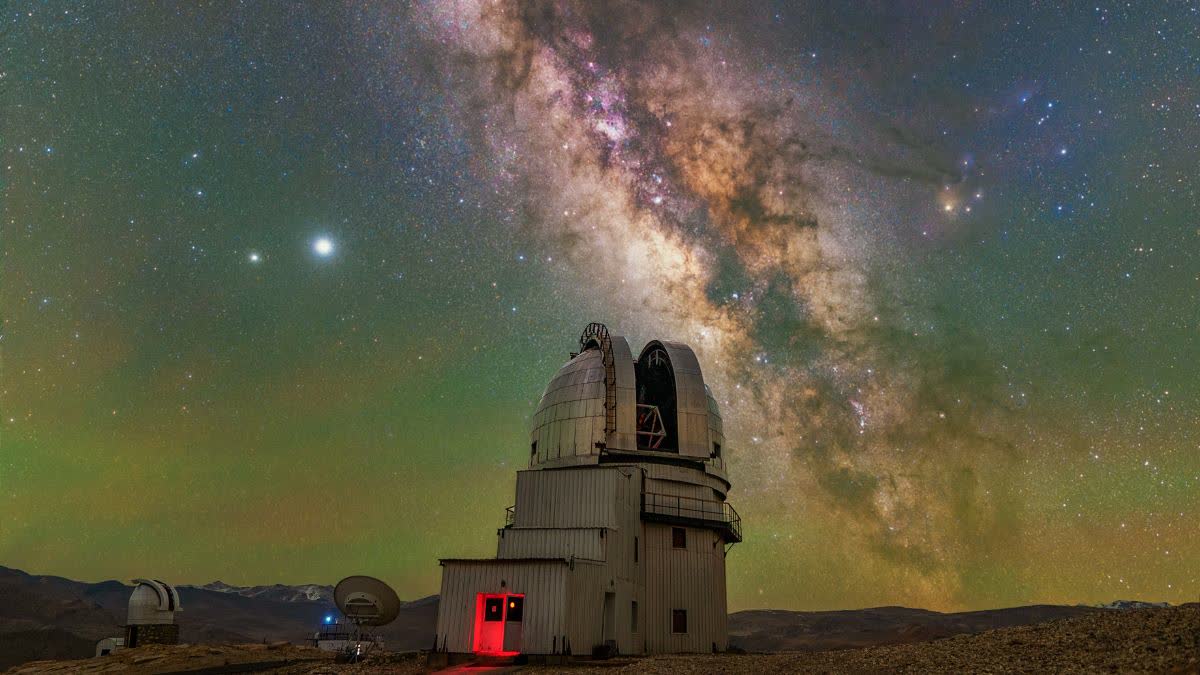By Anubha Jain
Bangalore: Our galaxy, the Milky Way, is just one among billions, a barred spiral containing our solar system, stars, planets, and cosmic objects. The Milky Way is part of the local group of galaxies and lies in the Virgo Supercluster. From Earth, it appears as a hazy band of light across the night sky, filled with distant stars too far to be seen individually.
"The Milky Way, a mini-universe in itself, is home to several satellite galaxies. Galaxies are formed in groups and clusters. The Milky Way is as old as the universe itself, given the vast age of the cosmos. Along with focussing on its formation, we must understand how the galaxy evolved and how it has shaped over time," Prof Annapurni Subramaniam, Director of the Indian Institute of Astrophysics (IIA) told ETV Bharat in an exclusive interview.
Proto Galaxy to Spiral Galaxy
A protogalaxy is a galaxy's first step in its formation, made up of hydrogen gas and dark matter. Most spiral galaxies, like the Milky Way, have a mini-elliptical galaxy at their centre, often with a small bulge and central bar. Subramaniam explained that a large cloud of gas (mostly hydrogen) cools, causing particles to clump together due to gravity, which begins star formation.
As the cloud condenses, it collapses to form stars, releasing energy and heat. The cloud shrinks, conserving angular momentum, which causes it to spin faster and flatten into a disc, and gaps become rotating fluid. This spinning disc is where stars and planets form. Over time, this rotation leads to the creation of disks of spiral galaxies, which are further shaped by galaxy interactions and mergers.
The future of the Milky Way is a celestial collision
Scientists predict that in about 4.5 billion years, the Milky Way and Andromeda galaxies will collide, causing brief bursts of star formation. After the merger, the new galaxy may take on an elliptical shape with less new star formation. The Sun will likely be pushed to a new region, but Earth won't be destroyed. Although stars won't collide, their orbits will shift, and our solar system could move farther from the galactic centre.
Subramaniam provided an example involving the Sun.
“If the Sun were to collide with a star, we would need to predict the paths of the Sun and nearby stars. Similarly, galaxies move through space, sometimes colliding or forming binary pairs. The Large and Small Magellanic Clouds are the closest galaxies to the Milky Way, but we don’t fully understand their movements or how they pass by the Milky Way. To track their orbits and speeds, we rely on data collected over the past 20 years. However, determining the mass of these galaxies is crucial to understanding whether they will collide with the Milky Way," she said.
"While data suggests a possible collision with Andromeda, earlier research indicates that the Magellanic Clouds may have originated from another galaxy interacting with Andromeda. Thus, we cannot fully rely on collision models, as uncertainties remain, especially regarding the mass and velocity of these galaxies," she added.
As per studies, over the next few billion years, star formation in the Milky Way will slow as gas depletes, potentially ceasing in 10-15 billion years. The galaxy will then consist mainly of old, faint stars. While some stars still form in the spiral arms, most gas is already used or locked in stars. As time passes, stars will age and die, ending as white dwarfs, neutron stars, or black holes.
“In a group of galaxies, more massive galaxies are typically found closer to the central regions and often lack gas. Gas is removed from these galaxies for several reasons, including its consumption to form stars. Additionally, ram pressure, caused due to the galaxy’s motion within a cluster, can strip away gas. The ram pressure force from the intracluster medium is stronger than the gravitational pull that binds the gas to the galaxy," Subramaniam explained.
The Large Magellanic Cloud has gas, while the Small Magellanic Cloud has even more, she noted, adding these clouds are dynamically influenced by the Milky Way system, and it is unusual to find such gas-rich galaxies near the Milky Way. Therefore scientists suggest that they are passing by and being deflected by another system. Additionally, she explained that galaxies become red and dead if they evolve in isolation, deprived of mergers or gas infall/accretion.
Impact of Cosmic Radiation and the Doppler Shift
Subramaniam discussed the impact of cosmic radiation and the early universe on the formation of the Milky Way, saying, “The formation of the Milky Way didn’t require any special conditions, except that it avoided being in a highly dense area where it could have been absorbed or merged with another galaxy. This allowed the galaxy to survive longer, maintaining its spiral structure."
She also explained the role of the Doppler shift or effect and spectroscopy in understanding the Milky Way. "To measure the motion and speed of objects, we rely on the Doppler effect. This fundamental concept allows astronomers to determine if an object is moving and at what speed. There are two key aspects: a positional shift, which shows that something is moving, and a change in wavelength or frequency, which indicates whether the object is moving toward or away from the observer. Essentially, the Doppler effect helps us track how galaxies and stars move by analysing shifts in their light.”
Gaia mission and Hubble Space Telescope
Using two of the world’s most powerful space telescopes—the NASA and ESA’s Hubble Space Telescope and ESA’s Gaia mission—astronomers have made the most precise measurements to date of the universe’s expansion rate.
Subramaniam noted that the data from the Hubble Space Telescope is made publicly available after the proprietary period, allowing anyone to download and use it. Astronomers throughout the world routinely use this valuable data in their research.
Highlighting the different telescopes, Subramaniam explained, “The Hubble Space Telescope focuses on distant objects with high resolution and detail. In contrast, Gaia offers a broader field of view, efficiently scanning the sky. For observing distant, dimmer objects and to study red-shifted galaxies in infrared, astronomers turn to the James Webb Space Telescope (JWST), which is bigger than Hubble.”
JWST focuses on capturing molecular lines present on the disc of the planet-forming stars and studying galaxies' molecules like a poly aromatic hydrocarbon. It is particularly useful for observing galaxies with significant redshift, allowing astronomers to look back in time and witness the formation of galaxies, she further explained.
The JWST has spotted the most distant known galaxy, JADES-GS-z14-0, just 290 million years after the Big Bang, showing signs of maturity with oxygen present. However, Hubble previously observed GN-z11, a galaxy from 400 million years after the Big Bang, which is much smaller and has only 1 per cent of the Milky Way's stellar mass. Meanwhile, ESA's Gaia Observatory completed its mission on January 15, 2025, after over a decade of mapping the Milky Way. By 2030, Gaia will release data on black holes, stars, and other cosmic objects discovered during its mission.
Role of AI and ML in Astronomy
When asked about the role of Artificial Intelligence (AI) and Machine Learning (ML) in astronomy, Subramaniam said that AI and ML have become integral to modern astronomy, and they are now standard tools in the field.
"Astronomy generates vast amounts of curated data, which is used to train AI and ML models. Astronomy is contributing to its growth from a very early age. Without these technologies, it would be impossible to effectively process such a deluge of astronomical data and extract meaningful scientific insights. AI and ML are crucial for exploring complex scientific questions, such as those posed by the Gaia mission, which produces enormous datasets. These tools help address unsolved strings, like galaxy mergers, and allow astronomers to analyze data more efficiently and accurately," she added.
Senior Professor and researcher Shrisha Rao at IIIT Bengaluru in an interview with ETV Bharat said that by automating data analysis, identifying patterns, and making predictions, these technologies are reshaping the field of astrophysics and enabling breakthroughs in galaxy mapping. At its core, AI involves the development of algorithms that allow machines to perform tasks traditionally requiring human intelligence. AI methods are addressing increasingly complex challenges in astrophysics and galaxy mapping.
Rao further said that one of the earliest and most impactful uses of ML in astrophysics is the automated classification of galaxies. With projects like the Sloan Digital Sky Survey (SDSS), the number of observed galaxies grew exponentially, making manual classification infeasible. Similarly, traditional spectroscopic methods for measuring redshift are accurate but time-intensive and limited by telescope availability. Now ML models predict redshifts using photometric data (brightness in different filters).
Algorithms like Random Forests and Neural Networks have been trained on spectroscopic data to provide accurate photometric redshift estimates, enabling large-scale surveys like DES (Dark Energy Survey). AI helps in mapping the universe's large-scale structure by analyzing cosmological simulations and observational data; Anomaly Detection; Telescope scheduling and optimization, he added.
Simulations and Emulators
Rao said that Cosmological simulations, such as Illustris or EAGLE, require significant computational resources. AI-based emulators can approximate these simulations at a fraction of the computational cost. Techniques like Generative Adversarial Networks (GANs) or Variational Autoencoders (VAEs) generate synthetic data that mimic real observations or simulations. For example, GANs can create realistic galaxy images for training ML models.
He said that as AI becomes integral to astrophysics, the need for interpretability grows. Methods like SHAP (Shapley Additive explanations) or LIME (Local Interpretable Model-agnostic Explanations) help astronomers understand why models make specific predictions, bridging the gap between AI and domain expertise.
However, challenges remain, including data quality and bias, scalability, and ethical concerns like data privacy and misuse of technology.
In the end, he stated that looking ahead, with data from instruments like the James Webb Space Telescope (JWST) and the Euclid mission, AI-driven methods and AI will be key to identifying habitable exoplanets and biosignatures, exploring dark matter and dark energy through precision cosmology, and creating detailed 3D maps of the universe’s evolution.
Collaborations between astronomers, computer scientists, and statisticians will drive the development of more robust and interpretable AI models, ensuring that astrophysics remains at the forefront of scientific discovery. As AI tools evolve and integrate deeper into the field, they promise to foster a new era of exploration, he added.



